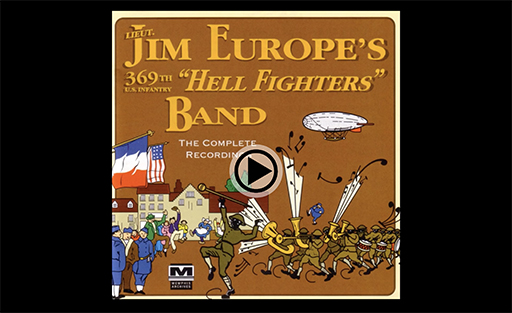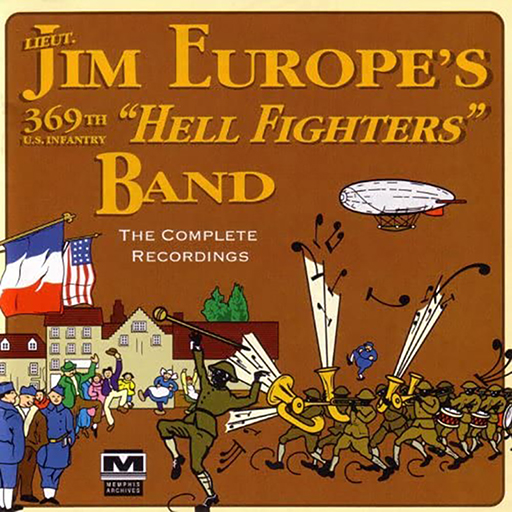1.4.3 James Reese Europe
Among the soldiers in the 369th Infantry Regiment were 44 members of the regimental band under the leadership of James Reese Europe (1880–1919). He was an African-American jazz musician, conductor and composer whose claim to fame is introducing jazz (or ragtime) music to Europe. He was also an officer in charge of the machine gun squad, and in this role the first African-American to command troops in wartime.
In June 1918, James (Jimmy) Europe was hospitalised following a German gas attack. While recovering in a field hospital, he composed the song On Patrol in No Man’s Land [Tip: hold Ctrl and click a link to open it in a new tab. (Hide tip)] , which became a popular song for his band to play after their return to the USA. You can listen to the song in full via the link above, or alterntaively, a short excerpt from the link here:

Figure 11 shows a picture of the album cover – which is an interesting document in itself, suggesting rather a more fun time in France than was likely had by the band and the rest of the regiment. Here the Black soldiers march in a band led (presumably) by Europe, playing their music to appreciative civilian audiences. A soldier can be seen dancing in the background. Here, too, a Zeppelin is in the sky, but this one, unlike Pippin’s in Figure 10, is not on fire.
After his return to the USA, Europe’s band went on tour, but Europe was murdered by a band member in an argument in May 1919. In acknowledgement of his services to US music, he received an official funeral in New York City – the first African-American to be given such an honour.
There is plenty of material online to allow students to research this topic, and many photographs and posters to make this a very visual topic, too. Perfect for a project, perhaps even with the Music Department..
As we have seen, participating in the war in Europe did not immediately open up opportunities for African-Americans. Racist views and segregation persisted. A 1919 publication quoted a white man from New Orleans who exclaimed in response to the raising of money for the war effort by African-Americans: ‘You niggers are wondering how you are going to be treated after the war. Well, I’ll tell you, you are going to be treated exactly like you were before the war. This is a white man’s country and we expect to rule it’ (cited in McDaniels, 2014).
Did you know?
Further reading
There is a lot of information available online, and students could be encouraged to do a research project on the ‘Harlem Hellfighters’ or extend this into a more general project on African-American soldiers in the war. There is additional information in Olusoga’s The World’s War (2014).
An excellent monograph on the subject is Nelson’s A More Unbending Battle (2009), which is freely available in the internet achive.
Another source which is freely available is Harris, Harlem’s Hell Fighters (2003). Harlem's hell fighters : the African-American 369th Infantry in World War I : Harris, Stephen L
There are photographs of members of the 369th Infantry Regiment and interesting propaganda posters in this online article in the German magazine Der Spiegel (although the text is in German).
This articlewritten by an archivist at the American National Archives who identifies nine soldiers from the 369th Infantry Regiment in a photograph and provides a detailed account of their war experiences and their backgrounds and is an interesting piece of historical detective work.
In addition to Anne Monahan’s 2008 article, there is also a monograph on Pippin: Anne Monahan, Horace Pippin, American Modern (Yale University Press, Yale 2020).
In the next section we will examine the war experiences of First Nation Canadians with a case study of Mike Mountain Horse who fought in Europe as part of Britain’s dominion troops.

